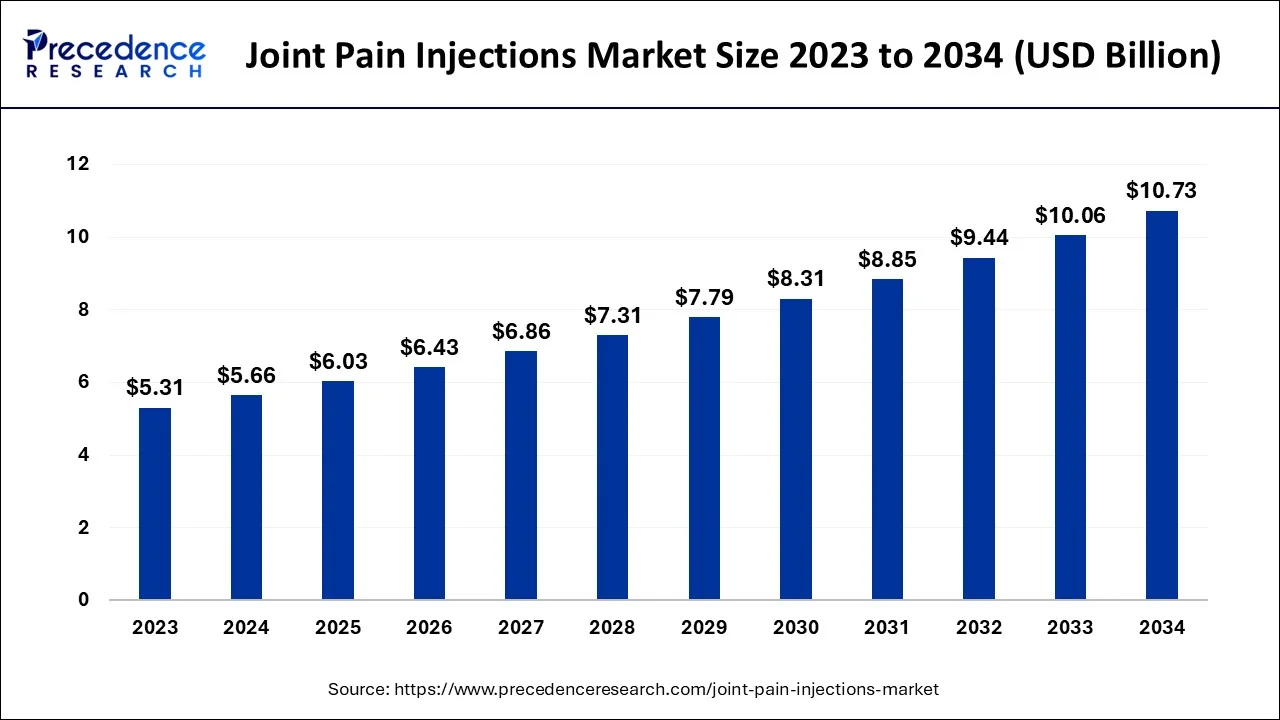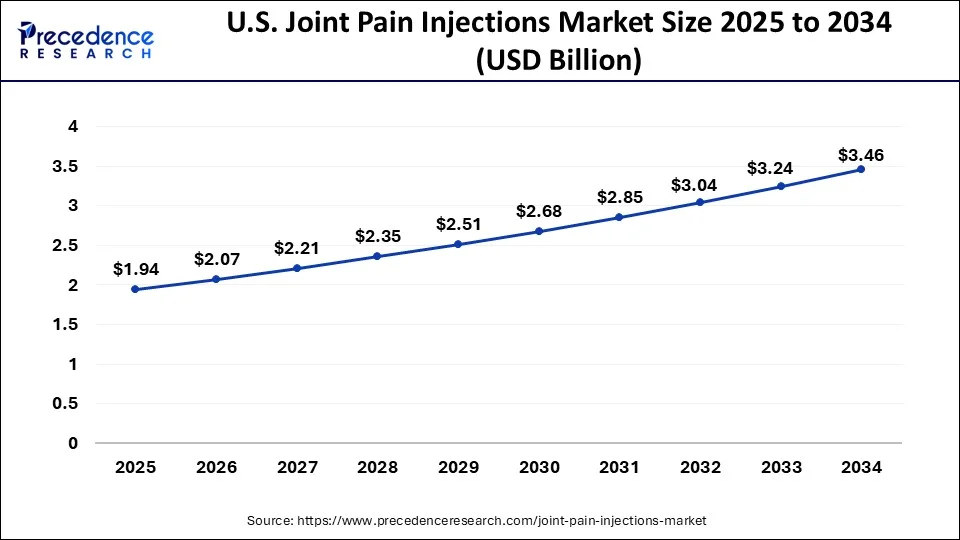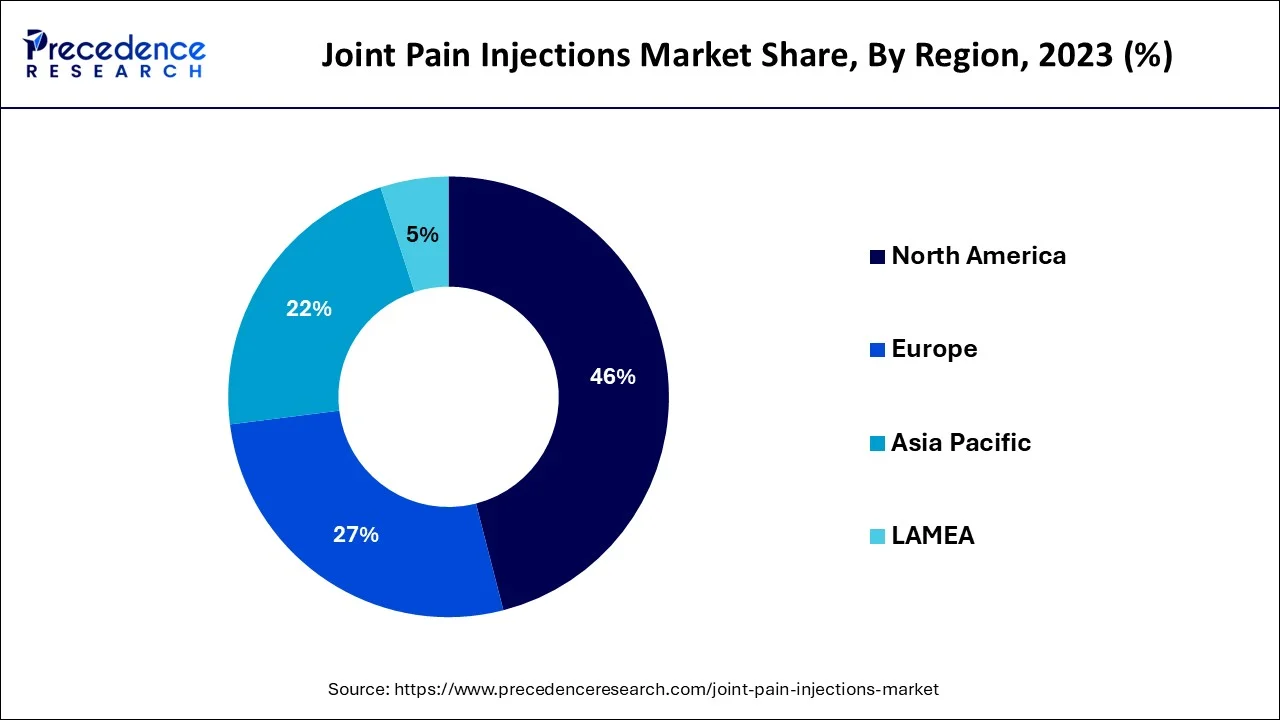What is Joint Pain Injections Market Size?
The global joint pain injections market size is estimated at USD 6.03 billion in 2025 and is predicted to surpass around USD 11.36 billion by 2035, expanding at a CAGR of 6.54% between 2026 and 2035.

Market Highlights
- North America dominated joint pain injections market in 2025.
- By injection type, the hyaluronic acid injections segment dominated the market in 2025.
- By injection type, the corticosteroid segment type is expected to witness a significant increase in its market revenue during the predicted timeframe.
- By distribution channel, the retail pharmacies segment led the market in 2025.
- By distribution channel, the online pharmacies segment is expected to increase its market share during the forecast period.
Joint Pain Injections Market Growth Factors
Any of the ligaments, bursae, or tendons that surround the joint can be injured, causing joint discomfort. Joint pain injections are medications that are injected directly into the joints to assist reduce inflammation and discomfort in the patient. Inflammatory joint disorders such as psoriatic arthritis, rheumatoid arthritis, bursitis, osteoarthritis, gout, and other types of joint pain are commonly treated with joint pain injections, also known as intra-articular injections.
Arthritis is a joint illness characterized by symptoms such as joint pain, stiffness, redness, and a decrease in physical activity. Osteoarthritis, or degenerative joint disease, and rheumatoid arthritis, an inflammatory illness affecting the feet and hands, are the two most frequent types of arthritis. Osteoarthritis can develop as a result of a loss of bone mineral density, rising obesity rates, age, and a lack of physical activity. Injections of corticosteroids and hyaluronic acid are commonly used to relieve inflammation and discomfort in afflicted joint locations.
The rising frequency of arthritis and musculoskeletal problems is fueling demand for joint pain injections, particularly among people aged 65 and over, who are more prone to joint discomfort. However, a lack of awareness about these injections, as well as the expensive cost of the medicines, may limit the market's expansion.
The global joint pain injections market is expected to be driven by a growth in the elderly population, an increase in the frequency of joint disorders, and high unmet medical needs over the forecast period.
The majority of joint diseases are diagnosed in elderly persons. Placental tissue matrix and platelet-rich plasma injections, according to the research, have demonstrated to be helpful in lowering inflammation, discomfort, and infection rates at the joint site. The rising prevalence of arthritis, the growing geriatric patient population, and the increasing number of new product releases by numerous key players are all expected to fuel the expansion of the joint pain injections market over the forecast period.
Government organizations' increasing spending in research and development in the creation of novel and cost-effective medicines are factors driving the growth of the joint pain injections market over the forecast period.
During the projected period, the global joint pain injections market is expected to rise due to an increase in the prevalence of osteoarthritis and an increase in the need for cost-effective therapies. Moreover, the expanding ageing population and technological advancements are expected to propel the joint pain injections market further throughout the forecast period.
However, the shortage of arthritis specialists in developing countries and the high cost of treating arthritis are projected to restrain the global joint pain injections market's growth over the forecast period.
The rising prevalence of osteoarthritis across a large portion of the population could be a key growth driver for the joint pain injections market. The market for global joint pain injections may benefit from the shift in demand for minimally invasive operations.
Osteoarthritis affects more than 32.5 million persons in the U.S., according to the Centers for Disease Control and Prevention. These frightening statistics highlight the urgent need for osteoarthritis treatment, driving up demand for joint pain injection during the forecast period.
Market Scope
| Report Coverage | Details |
| Market Size In 2025 | USD 6.03 Billion |
| Market Size In 2026 | USD 6.43 Billion |
| Market Size by 2035 | USD 11.36 Billion |
| Growth Rate From 2026 to 2035 | CAGR of 6.54% |
| Largest Market | North America |
| Base Year | 2025 |
| Forecast Period | 2026 to 2035 |
| Segments Covered | Injection Type, Distribution Channel, and Region |
| Regions Covered | North America, Europe, Asia-Pacific, Latin America and Middle East & Africa |
Segment Insights
Injection Type Insights
Based on the injection type, the hyaluronic acid injections dominate the joint pain injections market during the forecast period. The increasing desire for aesthetic beauty, driven by the less invasive nature of the treatments and the increasing efficiency of the hyaluronic acid injections, is one of the key factors driving the hyaluronic acid injections segment. The advent of new products and related new indications, as well as increased awareness of hyaluronic acid injections in developed and developing countries, are fueling the hyaluronic acid injections segment expansion.
The corticosteroid injections is expected to grow at rapid pace during the forecast period. The increased occurrences of bone and joint illnesses, rising obesity rates globally, changing and unhealthy lifestyles of people, and rising government awareness programs for joint problems are some of the factors that would propel the growth of corticosteroid injections market during the forecast period.
Distribution Channel Insights
Based on the distribution channel, the retail pharmacies dominate the joint pain injections market during the forecast period. The joint pain injections are mostly purchased from retail pharmacies. Therefore, it is expected to grow at a rapid pace.
The online pharmacies segment is expected to grow at rapid pace during the forecast period. The rising internet penetration in the emerging nations is driving the growth of segment. Also, the trend of digitalization has contributed towards the growth of online pharmacies segment to the greater extent.
Regional Insights
U.S. Joint Pain Injections Market Size and Growth 2026 to 2035
The U.S. joint pain injections market size is valued at USD 1.94 billion in 2025 and is predicted to surpass around USD 3.65 billion by 2035, expanding at a CAGR of 6.52% between 2026 to 2035.

The U.S. is the major contributor to the North American joint pain infections market due to its large geriatric population, high prevalence of osteoarthritis and joint disorders, and advanced healthcare infrastructure that enables early diagnosis and treatment. Additionally, widespread adoption of innovative therapies, surgical interventions, and strong government healthcare spending further drive market growth in the country.
Based on the region, the North America segment dominated the market in 2025, in terms of revenue. This is attributed to the easy availability of anabolic steroids, greater public awareness about the personal health, and increased demand among professional athletes and sportspersons.

What Makes Asia Pacific the Most Opportunistic Market for Joint Pain Infections?
The Asia-Pacific is estimated to be the most opportunistic segment during the forecast period. This is attributed to the high acceptance of viscosupplementation in the U.S., increased prevalence of joint-related disorders, technological advancements, an increase in ageing population, and a high prevalence of healthcare spending in the region, North America is expected to grow at a rapid pace.
China is a major contributor to the Asia Pacific joint pain infections market due to its large and aging population, increasing prevalence of osteoarthritis and musculoskeletal disorders, and rising awareness of advanced treatment options. Rapidly improving healthcare infrastructure and growing adoption of minimally invasive surgical procedures and innovative therapies further drive market growth in the country.
Why is Europe Considered a Significantly Growing Area?
Europe is expected to grow significantly in the joint pain injections market during the forecast period. The increasing osteoarthritis, as well as an aging population in Europe, is contributing to the increased demand for joint pain injections. This, in turn, increases the research and development for innovating new injections. At the same time, to reduce the surgeries, their use is also rising, which in turn, increases their production. This is further supported by the government as well as regulatory bodies. Thus, all these factors promote the market growth.
The regional market growth is also driven by an increasing elderly population, the rising prevalence of osteoarthritis, and wider access to various types of therapies. The high prevalence of musculoskeletal disorders, including joint pain, has increased demand for effective treatments, such as joint pain injections. As the aging population grows rapidly, the incidence of joint-related issues is expected to rise even further, boosting the demand for pain management solutions. Countries like Germany, France, and the UK lead in the region due to their strong healthcare infrastructure, robust government support, and well-established insurance systems.
What Potentiates the Market within Latin America?
The joint pain infections market in Latin America is driven by a growing middle-class population, increased healthcare investments, and rising awareness about joint pain management solutions. Brazil and Mexico are key players in the region, offering opportunities in both the private and public sectors. Rising disposable incomes and improved healthcare infrastructure are also enabling better access to advanced pain management solutions. This economic growth allows healthcare providers to adopt and offer innovative therapies, thus advancing the market.
What Opportunities Exist in the Middle East & Africa?
The Middle East & Africa (MEA) offers immense opportunities in the market, supported by rising cases of joint conditions and the growing adoption of advanced orthopedic care, which help drive market demand. The region is also witnessing increasing investments in hospital infrastructure along with the rise of medical tourism, which further drives market expansion. South Africa, the UAE, and Saudi Arabia are leading players in the region, where urban populations are increasingly adopting non-surgical pain management solutions such as joint pain injectables.
Joint Pain Injections Market Companies
- Anika Therapeutics Inc.
- Bioventus
- Ferring Pharmaceuticals Inc.
- Sanofi
- Zimmer Biomet Holdings Inc.
- Allergen Plc.
- Pfizer Inc.
- Chugai Pharmaceutical Co. Ltd
- SEIKAGAKU Corporation
- Ferring B.V.
Recent Developments
- In May 2025, an announcement focusing on the availability of joint pain treatments with long-term relief to the patients, as well as a variety of joint issues were added by the London Cartilage Clinic was made. Furthermore, it was anticipated that this solution will reduce the tendon or chronic joint discomfort while improving the mobility as per London clinic.
- In May 2025, a new ultrasound machine was introduced by the WellSpan Evangelical Community Hospital, which will be used for guiding injections at WellSpan's Orthopedics clinic in Selinsgrove. With the help of this new ultrasound machine, non-surgical injections, which can deliver targeted joint pain relief and reduce inflammation, will be developed, where Dr. Edward Gusick will work with the patients.
- In May 2025, a drug-free treatment protocol focusing on adults 55 and older who want to avoid surgery, Rochester Arthritis & Joint Pain Center, which is the supplier of non-surgical joint pain solutions, is now offering cortisone injections. Thus, this injection helps adults suffering from chronic arthritis and mobility issues by stimulating the body's natural healing processes.
(Source: https://news.marketersmedia.com)
(Source: https://www.dailyitem.com)
(Source: https://www.lelezard.com)
Segments Covered in the Report
By Injection Type
- Corticosteroid Injections
- Hyaluronic Acid Injections
- Platelet-rich Plasma Injections
- Placental tissue matrix (PTM) Injections
By Joint Type
- Knee and Ankle
- Hip
- Shoulder and Elbow
- Spinal Joints
- Others
By Distribution Channel
- Hospital Pharmacies
- Retail Pharmacies
- Online Pharmacies
By Product Type
- Pre-filled injections
- Vials
By Region
- North America
- Europe
- Asia-Pacific
- Latin America
- Middle East and Africa
For inquiries regarding discounts, bulk purchases, or customization requests, please contact us at sales@precedenceresearch.com
Frequently Asked Questions
Ask For Sample
No cookie-cutter, only authentic analysis – take the 1st step to become a Precedence Research client




 sales@precedenceresearch.com
sales@precedenceresearch.com
 +1 804-441-9344
+1 804-441-9344